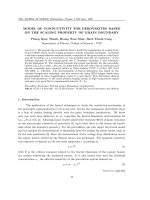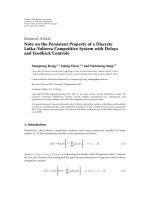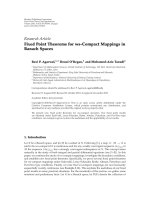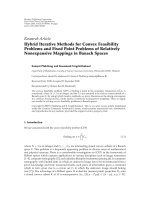Research report: "The general property of weak compatible mappings in metric spaces O" pptx
Bạn đang xem bản rút gọn của tài liệu. Xem và tải ngay bản đầy đủ của tài liệu tại đây (156.69 KB, 8 trang )
Common fixed points for weakly compatible maps in
o-metrizable spaces
Dinh Huy Hoang
(a)
, Le Khanh Hung
(a)
, Bui Thi Thuy Vinh
(b)
Abstract. In this paper, we prove some common fixed point theorems for weakly
compatible selfmappings of o-metrizable spaces.
I. Introduction
It is well known that Banach contraction principle is a fundamental resul in
fixed point theory, which has been used and extended in many different directions.
However, it has been observed in [3] that some of the defining properties of the metric
are not needed in the proofs of certain metric theorems. Motivated by this fact, Hicks
in [3], Aamiri and Moutawakil in [1] established some common fixed point theorems
in symmetric spaces for weakly compatible maps. The main purpose of this paper
is to give some common fixed point theorems for weakly compatible selfmappings of
o-metric spaces.
We begin at some basic definitions used in this paper.
1.1. Definition. Let X be a topological space and d be a nonnegative real-
valued funtion defined on X × X such that d(x, y) = 0 if and only if x = y. Such
a function d is called an o-metric and X is called an o-metrizable space provided
that a subset U of X is open if and only if d(x, X \ U) > 0 for each x ∈ U, where
d(x, X \ U) = inf{d(x, y) : y ∈ X \ U}.
1.2. Definition. Let (X, d) be an o-metrizable space and {x
n
} be a sequence in
X. {x
n
} is called a Cauchy sequence if for each ε > 0 there exists n
0
∈ N satisfying
d(x
n
, x
n+m
) < ε for all n ≥ n
0
and m ∈ N. (X, d) is called a complete space if for
every Cauchy sequence {x
n
} in X, there exists x ∈ X such that x
n
converges to x.
A sequence {x
n
} is said to be d-converging to x if lim
n→∞
d(x, x
n
) = 0. An o-
metrizable space (X, d) is called to have property (W
4
) if for any two sequences
{x
n
}, {y
n
} and x in X, lim
n→∞
d(x, x
n
) = 0 and lim
n→∞
d(y
n
, x
n
) = 0 imply that lim
n→∞
d(x, y
n
) =
0.
1.3. Definition. Let A and B be two selfmappings of an o-metrizable space
(X, d). A and B are said to be compatible if lim
n→∞
d(ABx
n
, BAx
n
) = 0, whenever
{x
n
} is a sequence in X such that lim
n→∞
d(t, Ax
n
) = lim
n→∞
d(t, Bx
n
) = 0 for some
t ∈ X, where Ax is A(x).
A and B are said to be weakly compatible if they commute at their coincidence
points.
We say that A and B satisfy the property (E.A) if there exists a sequence {x
n
}
such that lim
n→∞
d(t, Ax
n
) = 0 and lim
n→∞
d(t, Bx
n
) = 0 for some t ∈ X.
1
NhËn bµi ngµy 18/11/2008. Söa ch÷a xong 24/4/2009.
II. Main results
2.1. Lemma. Let (X, d) be an o-metrizable space and {x
n
} be a sequence in X.
a) If {x
n
} d-converges to x ∈ X, then {x
n
} converges to x.
b) If X is Hausdorff and {x
n
} converges to x ∈ X, then {x
n
} d-converges to x.
Proof. a) Let U be an open neighborhood of x. Then r := d(x, X \ U) > 0. Since {x
n
}
is a sequence d-converging to x, there exists n
0
∈ N such that d(x, x
n
) < r for each
n ≥ n
0
. This yields x
n
∈ U for each n ≥ n
0
. Hence {x
n
} converges to x.
b) For each ε > 0, let B(x, ε) = {y ∈ X : d(x, y) < ε}. Then there exists
m ∈ N such that {x
n
: n ≥ m} ⊂ B(x, ε). Indeed, suppose not. Then there
exists a subsequence {x
n
k
} of {x
n
} such that {x
n
k
} ⊂ X \ B(x, ε) and x
n
k
= x
n
l
if k = l. Put E = {x
n
1
, x
n
2
, . . .}. Since X is Hausdorff, E ∪ {x} is closed in X
and hence X \ (E ∪ {x}) is open in X. Let y ∈ X \ E. If y = x, then since
E ⊂ X \ B(x, ε) it follows d(y, E) ≥ ε > 0. If y = x, then y ∈ X \ (E ∪ {x}). Since
X \ (E ∪ {x}) is open, it follows d(y, E) ≥ d(y, E ∪ {x}) > 0. Hence X \ E is open
in X. This means that E is closed. But {x
n
k
} converges to x so x ∈ E. This is a
contradiction. Thus there exists m ∈ N such that x
n
∈ B(x, ε) for each n ≥ m. This
yields d(x, x
n
) < ε for each n ≥ m and hence lim
n→∞
d(x, x
n
) = 0.
2.2. Lemma. Let (X, d) be an o-metrizable space. Then the following are equiva-
lent
a) Every d-convergent sequences are Cauchy;
b) If {x
n
}, {y
n
} are sequences in X and x ∈ X such that lim
n→∞
d(x, x
n
) = lim
n→∞
d(x, y
n
)
= 0 then lim
n→∞
d(x
n
, y
n
) = 0.
Proof. Let a) hold. Assume that {x
n
}, {y
n
} are sequences in X, and x ∈ X such that
lim
n→∞
d(x, x
n
) = lim
n→∞
d(x, y
n
) = 0.
For each n ∈ N, put
z
2n−1
= x
n
, z
2n
= y
n
for n = 1, 2, . . . ,
then {z
n
} is a sequence d-converging to x, and so {z
n
} is Cauchy. It follows that for
each ε > 0, there exists n
0
∈ N such that
d(z
n
, z
n+m
) < ε for n ≥ n
0
, m ∈ N.
This yields
d(x
n
, y
n
) = d(z
2n−1
, z
2n
) < ε for n ≥ n
0
.
Hence lim
n→∞
d(x
n
, y
n
) = 0.
Now, suppose that b) holds and {x
n
} is a sequence d-converging to a point x ∈ X.
We will show that {x
n
} is a Cauchy sequence. Indeed, suppose not. Then there
exists ε > 0 such that for each n ∈ N, there exist m
n
> n and k
n
∈ N satisfying
d(x
m
n
, x
m
n
+k
n
) > ε. We can assume that m
n
+k
n
< m
n+1
for all n ∈ N. Hence {x
m
n
}
and {x
m
n
+k
n
} are two subsequences of {x
n
}. Since lim
n→∞
d(x, x
n
) = 0, it follows that
lim
n→∞
d(x, x
m
n
) = lim
n→∞
d(x, x
m
n
+k
n
) = 0.
By b), lim
n→∞
d(x
m
n
, x
m
n
+k
n
) = 0. This is contradiction. Hence {x
n
} is a Cauchy
sequence.
In what follows, we involve a function ϕ : R
+
→ R
+
which satisfies the following
conditions
(1) ϕ is nondecreasing on R
+
,
(2) lim
n→∞
ϕ
n
(t) = 0 for t > 0, where ϕ
2
(t) = ϕ(ϕ(t)), ϕ
3
(t) = ϕ(ϕ(ϕ(t))), . . .
For example, we could let ϕ(t) =
t
t+1
or ϕ(t) = αt for some α ∈ (0, 1).
2.3. Lemma. Let ϕ : R
+
→ R
+
be a function satisfying the above conditions (1),
(2). Then
ϕ(t) < t for each t > 0.
Proof. Assume that there exists t
0
> 0 such that ϕ(t
0
) ≥ t
0
. Since ϕ is nondecreasing,
ϕ
2
(t
0
) = ϕ(ϕ(t
0
)) ≥ ϕ(t
0
) ≥ t
0
. By induction, we can prove that ϕ
n
(t
0
) ≥ t
0
for each
n ∈ N. By the condition (2), we have a contradiction. Thus ϕ(t) < t for each t > 0.
2.4. Theorem. Let A and B be two weakly compatible self-mappings of an o-
metrizable, Hausdorff (X, d). If
(1) d(Ax, Ay) ϕ(d(Bx, By)) for all (x, y) ∈ X
2
,
(2) AX ⊂ BX,
(3) AX or BX is a complete subspace of X,
(4) d(AX) = sup{d(u, v) : u, v ∈ AX} < ∞,
then A and B have an unique common fixed point.
Proof. Let x
0
∈ X. Since AX ⊂ BX, there exists x
1
∈ X such that Ax
0
= Bx
1
.
Similarly, there exists x
2
∈ X such that Ax
1
= Bx
2
. Continuing in this argument,
there exists a sequence {x
n
} in X satisfying Ax
n−1
= Bx
n
. We claim that {Ax
n
} is
a Cauchy sequence. Indeed, we have
d(Ax
n
, Ax
n+m
) ϕ(d(Bx
n
, Bx
n+m
)) = ϕ(d(Ax
n−1
, Ax
n+m−1
))
ϕ
2
(d(Bx
n−1
, Bx
n+m−1
)) = ϕ
2
(d(Ax
n−2
, Ax
n+m−2
))
. . .
ϕ
n
(d(Ax
0
, Ax
m
)) ϕ
n
(d(AX)), for each n.
Since lim
n→∞
ϕ
n
(d(AX)) = 0, it follows that {Ax
n
} is a Cauchy sequence. Assume that
BX is a complete subspace of X. Then there exists u ∈ X such that Ax
n
→ Bu and
hence Bx
n
→ Bu. By Lemma 2.1, we have
lim
n→∞
d(Bu, Ax
n
) = lim
n→∞
d(Bu, Bx
n
) = 0. (a)
We show that Au = Bu. Indeed, we have
d(Au, Ax
n
) ϕ(d(Bu, Bx
n
)) < d(Bu, Bx
n
) for all n ∈ N.
Since (a) and X is Hausdorff, it follows that Au = Bu.
Since A and B are weakly compatible, it implies that
AAu = ABu = BAu = BBu.
Suppose that d(Bu, BBu) = 0. From (1), it follows that
d(Bu, BBu) = d(Au, ABu) ϕ(d(Bu, BBu)) < d(Bu, BBu),
which is a contradiction. Thus d(Bu, BBu) = 0 and hence BBu = Bu. Also
ABu = BAu = BBu = Bu,
which implies that Bu is a common fixed point of A and B.
Now, if AX is a complete subspace of X, then there exists x ∈ X such that
Ax
n
→ Ax and hence lim
n→∞
d(Ax, Ax
n
) = 0. Since AX ⊂ BX, there exists u ∈ X
such that Ax = Bu and then the proof that Bu is a common fixed point of A and B
is the same as that given when BX is complete.
Finally to prove uniqueness, suppose that there exist u, v ∈ X such that Au =
Bu = u and Av = Bv = v. If d(u, v) = 0, then
d(u, v) = d(Au, Av) ϕ(d(Bu, Bv)) = ϕ(d(u, v)) < d(u, v),
which is a contradiction. Consequently d(u, v) = 0 and hence u = v.
2.5. Theorem. Let (X, d) be a Hausdorff, o-metrizable space, A and B be two
weakly compatible self-mappings of (X, d) such that
(1) d(Ax, Ay) ϕ(max{d(Bx, By), d(Bx, Ay), d(Ay, By)}) for all (x, y) ∈ X
2
,
(2) A and B satisfies the property (E.A),
(3) AX ⊂ BX.
If AX or BX is closed in X and all d-convergent sequences in X are Cauchy, then
A and B have an unique common fixed point.
Proof. Since A and B satisfy the property (E.A), there exists a sequence {x
n
} in X
such that lim
n→∞
d(t, Ax
n
) = lim
n→∞
d(t, Bx
n
) = 0 for some t ∈ X. By Lemma 2.2, we
deduce that lim
n→∞
d(Ax
n
, Bx
n
) = 0.
Suppose that BX is closed in X. Since lim
n→∞
d(t, Bx
n
) = 0, it follows that the
sequence {Bx
n
} converges to t. This implies t ∈ BX. Hence t = Bu for some u ∈ X.
We show that Au = Bu. Indeed, by (1), we have
d(Au, Ax
n
) ϕ(max{d(Bu, Bx
n
), d(Bu, Ax
n
), d(Ax
n
, Bx
n
)})
< max{d(Bu, Bx
n
), d(Bu, Ax
n
), d(Ax
n
, Bx
n
)}.
Let n → ∞, we have d(Au, Ax
n
) → 0. Since X is Hausdorff, Au = Bu. The weak
compatibility of A and B implies that AAu = ABu = BAu = BBu. Let us show
that Au is a common fixed point of A and B.
Suppose that AAu = Au. By (1), we have
d(Au, AAu) ϕ(max{d(Bu, BAu), d(Bu, AAu), d(AAu, BAu)})
< max{d(Au, AAu), d(Au, AAu), 0}
= d(Au, AAu).
This is a contradiction. Hence Au = AAu = BAu and Au is a common fixed point
of A and B. The proof is similar when AX is closed in X, since AX ⊂ BX. If
Au = Bu = u and Av = Bv = v, and u = v, then (1) gives
d(u, v) = d(Au, Av) ϕ(max{d(Bu, Bv), d(Bu, Av), d(Bv, Av)})
= ϕ(d(u, v)) < d(u, v),
which is a contradiction. Thus u = v and the common fixed point of A and B is
unique.
2.6. Corollary. Let (X, d) be a Hausdorff, o-metrizable space, A and B be two
weakly compatible, non-compatible self-mappings of (X, d) such that
(1) d(Ax, Ay) ϕ(max{d(Bx, By), d(Bx, Ay), d(Ay, By)}) for all (x, y) ∈ X
2
,
(2) AX ⊂ BX.
If AX or BX is closed in X and all d-convergent sequences in X are Cauchy, then
A and B have an unique common fixed point.
Proof. By definition 1.3, we deduce that two non-compatible self-mappings of (X, d)
satisfy the property (E.A). Hence, by Theorem 2.5, the proof is completed.
2.7. Theorem. Let (X, d) be a Hausdorff, o-metrizable space, A and B be two
weakly compatible self-mappings of (X, d) such that
(1) d(Ax, Ay) ϕ(max{d(Bx, By), d(Bx, Ay)}) for all (x, y) ∈ X
2
,
(2) A and B satisfies the property (E.A).
If BX is closed in X, then A and B have an unique common fixed point.
Proof. Since A and B satisfy the property (E.A), there exists a sequence {x
n
} in X
such that lim
n→∞
d(t, Ax
n
) = lim
n→∞
d(t, Bx
n
) = 0 for some t ∈ X. By Lemma 2.1,
{Ax
n
} and {Bx
n
} converge to t. Since BX is closed in X, there exists u ∈ X such
that t = Bu. By (1), we have
d(Au, Ax
n
) ϕ(max{d(Bu, Bx
n
), d(Bu, Ax
n
)})
< max{d(Bu, Bx
n
), d(Bu, Ax
n
)}.
Letting n → ∞, we have lim
n→∞
d(Au, Ax
n
) = 0 and hence the sequence {Ax
n
} con-
verges to Au. Since X is Hausdorff, Au = Bu. The weak compatibility of A and B
implies that ABu = BAu, and then
AAu = ABu = BAu = BBu.
Let us show that Au is a common fixed point of A and B. Suppose that AAu = Au.
In view of (1), it follows that
d(Au, AAu) ϕ(max{d(Bu, BAu), d(Bu, AAu)})
= ϕ(d(Au, AAu))
< d(Au, AAu).
This is a contradiction. Therefore Au = AAu = BAu and Au is a common fixed
point of A and B.
Assume that there exist u, v ∈ X such that Au = Bu = u, Av = Bv = v and
u = v. Then (1) gives
d(u, v) = d(Au, Av) ϕ(max{d(Bu, Bv), d(Bu, Av)})
< d(u, v).
We have a contradiction. Hence A and B have an unique common fixed point.
2.8. Theorem. Let (X, d) be a Hausdorff, o-metrizable space satisfying (W
4
) and
A, B, T and S be self-mappings of (X, d) such that
(1) d(Ax, By) ϕ(max{d(Sx, T y), d(Sx, By), d(T y, By)}) for all (x, y) ∈ X
2
,
(2) (A, S) and (B, T ) are weakly compatible,
(3) B and T satisfy the property (E.A),
(4) AX ⊂ TX and BX ⊂ SX.
If BX or SX is closed in X and all d-convergent sequences in X are Cauchy, then
A, B, T and S have an unique common fixed point.
Proof. Since B and T satisfy the property (E.A), there exists a sequence {x
n
} in
X such that lim
n→∞
d(t, Bx
n
) = lim
n→∞
d(t, T x
n
) = 0, for some t ∈ X. Hence, by
Lemma 2.2, lim
n→∞
d(Bx
n
, T x
n
) = 0 and lim
n→∞
d(T x
n
, Bx
n
) = 0. Since BX ⊂ SX, there
exists in X a sequence {y
n
} such that Bx
n
= Sy
n
for each n. Hence lim
n→∞
d(t, Sy
n
) =
0. By (1), we have
d(Ay
n
, Bx
n
) ϕ(max{d(Sy
n
, T x
n
), d(Sy
n
, Bx
n
), d(T x
n
, Bx
n
)}
ϕ max{d(Bx
n
, T x
n
), 0, d(T x
n
, Bx
n
)}
ϕ max{d(Bx
n
, T x
n
) + d(T x
n
, Bx
n
)}
< d(Bx
n
, T x
n
) + d(T x
n
, Bx
n
).
Letting n → ∞, we have lim
n→∞
d(Ay
n
, Bx
n
) = 0. By (W
4
), we deduce that lim
n→∞
d(t, Ay
n
) =
0. By Lemma 2.1, since lim
n→∞
d(t, Sy
n
) = 0, {Sy
n
} converges to t. If SX is closed in
X, then t = Su for some u ∈ X. If BX is closed in X, then since BX ⊂ SX, it
follows that t = Su for some u ∈ X. Hence
lim
n→∞
d(Su, Ay
n
) = lim
n→∞
d(Su, Bx
n
) = lim
n→∞
d(Su, T x
n
) = lim
n→∞
d(Su, Sy
n
) = 0.
Using (1), it follows that
d(Au, Bx
n
) ϕ(max{d(Su, T x
n
), d(Su, Bx
n
), d(T x
n
, Bx
n
)}.
Letting n → ∞, we have lim
n→∞
d(Au, Bx
n
) = 0. Since X is Hausdorff, Au = Su. The
weak compatibility of A and S implies that ASu = SAu and then
AAu = ASu = SAu = SSu.
On the other hand, since AX ⊂ T X, there exists v ∈ X such that Au = Tv. We
claim that T v = Bv. If not, condition (1) gives
d(Au, Bv) ϕ(max{d(Su, T v), d(Su, Bv), d(T v, Bv)})
ϕ(max{d(T v, Bv), d(Au, Bv)})
= ϕ(d(Au, Bv))
< d(Au, Bv),
which is a contradiction. Hence Au = Su = T v = Bv. The weak compatibility of B
and T implies that BT v = T Bv and then
T Tv = TBv = BT v = BBv.
Let us show that Au is a common fixed point of A, B, T and S. Suppose that AAu =
Au. By (1), we have
d(AAu, Au) = d(AAu, Bv) ϕ(max{d(SAu, T v), d(SAu, Bv), d(T v, Bv)})
ϕ(max{d(AAu, Au), d(AAu, Au), 0})
< d(AAu, Au),
which is a contradiction. Therefore Au = AAu = SAu and Au is a common fixed
point of A and S. Similarly, we prove that Au is a common fixed point of B and T.
Thus Au is a common fixed point of A, B, S and T .
Now, assume that there exist u, v X such that Au = Bu = Su = T u = u,
Av = Bv = Sv = Tv = v and u = v. Then, by (1), we have
d(u, v) = d(Au, Bv) (max{d(Su, T v), d(Su, Bv), d(T v, Bv)})
= (d(u, v)) < d(u, v).
This is a contradiction. Therefore u = v and the common fixed point is unique.
References
[1] M. Aamiri and D. El Moutawakil, Common fixed point under contractive conditions
in symmetric spaces, Applied Mathematics E-Notes, 3 (2003), 156-162.
[2] T. L. Hicks, Fixed point theorems for d-complete topological spaces, Inter. J. Math.
Sci., Vol. 15, No. 3 (1992), 435-440.
[3] T. L. Hicks, Fixed point theory in symmetric spaces with applications to proba-
bilistic space, Nonlinear Analysis, 36 (1999), 331-344.
[4] K. B. Lee, On certain g-first countable spaces, Pacific Journal of Mathematics,
Vol. 65, No. 1 (1976), 113-118.
[5] S. Padaliya and R. P. Pant, Common fixed point theorems for R-weakly commuting
mappings of type (A
f
), Soochow Journal of Mathematics, Vol. 31, No. 2 (2005), 155-
163.
Tóm tắt
Điểm bất động chung của các ánh xạ tơng thích yếu trong
không gian o-mêtric
Trong bài báo này, chúng tôi chứng minh một số định lý điểm bất động cho ánh
xạ tơng thích yếu của không gian o-mêtric.
(a) Vinh University, Vinh City, Nghe An
(b) Professional College, Nha Trang, Khanh Hoa.









